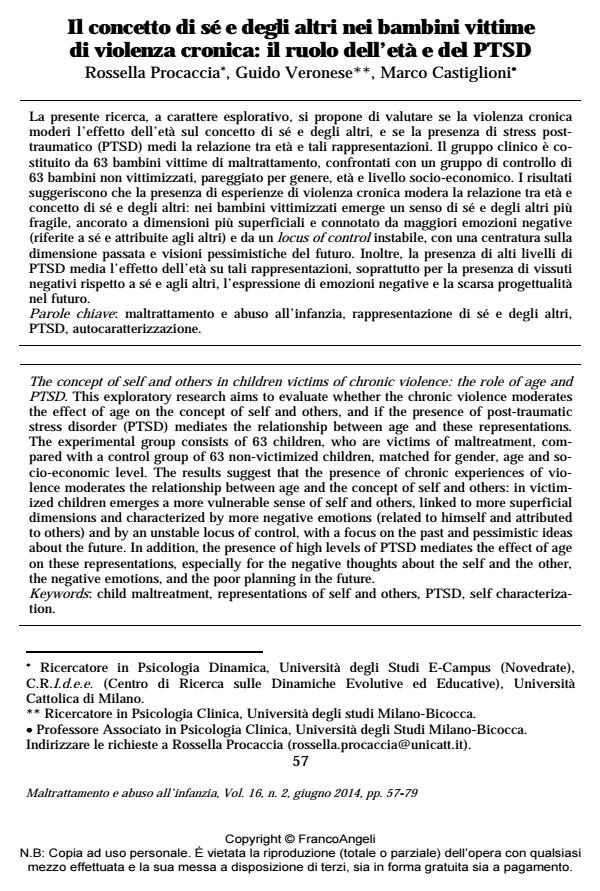The concept of self and others in children victims of chronic violence: the role of age and PTSD
Journal title MALTRATTAMENTO E ABUSO ALL’INFANZIA
Author/s Rossella Procaccia, Guido Veronese, Marco Castiglioni
Publishing Year 2014 Issue 2014/2
Language Italian Pages 23 P. 57-79 File size 108 KB
DOI 10.3280/MAL2014-002004
DOI is like a bar code for intellectual property: to have more infomation
click here
Below, you can see the article first page
If you want to buy this article in PDF format, you can do it, following the instructions to buy download credits

FrancoAngeli is member of Publishers International Linking Association, Inc (PILA), a not-for-profit association which run the CrossRef service enabling links to and from online scholarly content.
This exploratory research aims to evaluate whether the chronic violence moderates the effect of age on the concept of self and others, and if the presence of post-traumatic stress disorder (PTSD) mediates the relationship between age and these representations. The experimental group consists of 63 children, who are victims of maltreatment, compared with a control group of 63 non-victimized children, matched for gender, age and socio- economic level. The results suggest that the presence of chronic experiences of violence moderates the relationship between age and the concept of self and others: in victimized children emerges a more vulnerable sense of self and others, linked to more superficial dimensions and characterized by more negative emotions (related to himself and attributed to others) and by an unstable locus of control, with a focus on the past and pessimistic ideas about the future. In addition, the presence of high levels of PTSD mediates the effect of age on these representations, especially for the negative thoughts about the self and the other, the negative emotions, and the poor planning in the future.
Keywords: Child maltreatment, representations of self and others, PTSD, self characterization.
- Dalla violenza assistita al lutto traumatico: i bambini orfani speciali Marvita Goffredo, Francesca Lovero, Antonella Magno, Daniela Prudente, Daniela Racanelli, Alessandra Sgaramella, Marica Urbano, Alessandra Cervinara, Alessandro Costantini, Maria Grazia Foschino Barbaro, in MALTRATTAMENTO E ABUSO ALL'INFANZIA 1/2019 pp.73
DOI: 10.3280/MAL2019-001006 - Linguistic Predictors of Psychological Adjustment in Healthcare Workers during the COVID-19 Pandemic Marco Castiglioni, Cristina Liviana Caldiroli, Attà Negri, Gian Mauro Manzoni, Rossella Procaccia, in International Journal of Environmental Research and Public Health /2023 pp.4482
DOI: 10.3390/ijerph20054482 - Does resilience mediate the association between mental health symptoms and linguistic markers of trauma processing? Analyzing the narratives of women survivors of intimate partner violence Marco Castiglioni, Cristina Liviana Caldiroli, Gian Mauro Manzoni, Rossella Procaccia, in Frontiers in Psychology 1211022/2023
DOI: 10.3389/fpsyg.2023.1211022 - L'ascolto del minore vittima di violenza tra esigenze cliniche e giuridiche Rossella Procaccia, in MALTRATTAMENTO E ABUSO ALL'INFANZIA 2/2016 pp.7
DOI: 10.3280/MAL2016-002001 - Child abuse potential inventory in Italy: A comparative study of abusive and nonabusive parents Sarah Miragoli, Elena Camisasca, Paola Di Blasio, Luca Milani, Chiara Ionio, Nico Gizzi, Angela Cammarella, Marisa Malagoli Togliatti, in Journal of Child Custody /2016 pp.289
DOI: 10.1080/15379418.2016.1250145
Rossella Procaccia, Guido Veronese, Marco Castiglioni, Il concetto di sé e degli altri nei bambini vittime di violenza cronica: il ruolo dell’età e del PTSD in "MALTRATTAMENTO E ABUSO ALL’INFANZIA" 2/2014, pp 57-79, DOI: 10.3280/MAL2014-002004